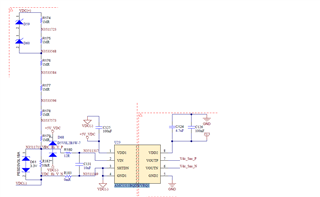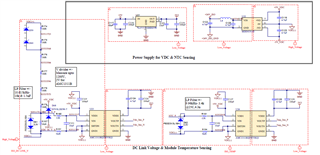Other Parts Discussed in Thread: TIDA-01541, , OPA211
Dear all,
I am using AMC1311B isolation amplifier for DC link voltage sensing in motor drive application. At No load to motor, DC link measurement is linear to actual values. However with load, Measured value (at AMC output) is showing negative drift wrt actual value. We are referring TIDA-01541. Below is the section of schematic used,

Please provide clarification for the following:
1.) What is the correct way of putting input filter components for single ended voltage measurements- either 12R+10nF+12R or 12R+10nF+0R
2.) How to connect SHTDN pin- either shorting it directly to VDC(-) or connecting it before lower side filter resistor.
3.) How Zener diode is used to detect under voltage.



